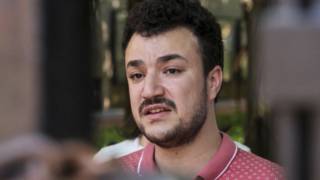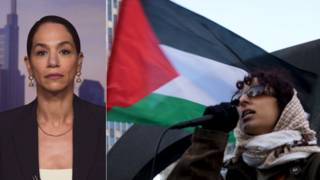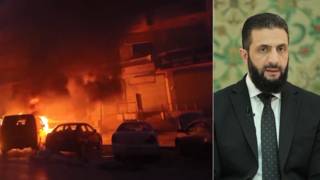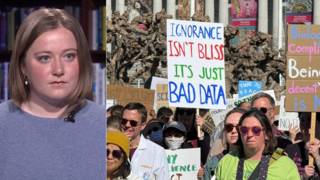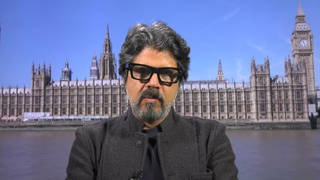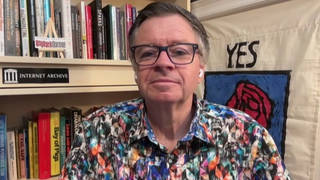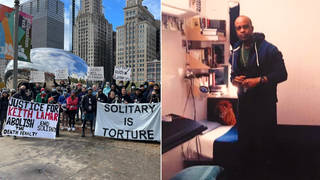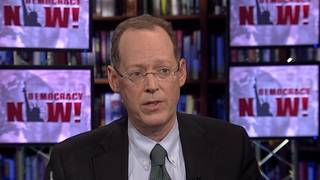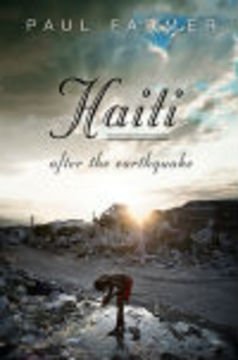
Read the first chapter of Haiti After the Earthquake, the new book by Paul Farmer, renowned physician and social justice advocate. On Thursday’s show we will talk to Farmer about his book, and his experience working with Special Envoy for Haiti Bill Clinton in post-earthquake recovery efforts.
Chapter 1: “Catastrophe”
On January 13, the day after an earthquake struck Haiti’s capital, I finally got through to Dr. Alix Lassegue, the medical director of Port-au-Prince’s largest hospital and a longtime friend. The hospital’s real name is l’Hopital de l’Universite d’Etat d’Haïti, but most people call it the General Hospital. I began trying to reach Lassegue a couple of hours after the quake. His cell phone number, like all the other numbers I tried, led to a recorded message or an ominous buzz. From what we knew at the time, the hospital was smack in the middle of the quake zone. The facility sat among a dozen government buildings, including the medical and nursing schools, and we could see from live reports that most of those buildings had collapsed — during business and school hours. It was clear that our work as health providers in Haiti would be changed forever.
So now what? It was hard to know how to prioritize anxieties, and as a doctor, I thought immediately of the General Hospital. It wasn’t hard to imagine the enormity of need in this struggling public facility which had, in the best of times, too many patients, too few staff, and far too few resources. After dozens of tries, it was almost a shock when I connected to Lassegue on a colleague’s cell phone.
“What do you most need?” I asked.
Lassegue would hear this question again and again over the next weeks and months, usually with scant practical outcome, but this was early in the game — less than twenty-four hours after the quake.
Of course he needed just about everything, including electricity, supplies, salaries, and medications; the hospital had been scrambling for all these even before the quake. He gave me a long and fairly specific list. He needed materials and labor to repair the damaged parts of the hospital, and engineers able to assess the structural integrity of the buildings still standing. He needed help trying to save the lives of those still trapped under collapsed buildings abutting the hospital grounds, including not only the nursing school next door — “a total loss, I fear, and all in it” — and nearby federal buildings, but also houses, businesses, and schools.
“It’s much worse than we thought,” Lassegue said. “Just managing proper disposal of the bodies is overwhelming us.” He needed help moving casualties out of the courtyards and into the morgue but couldn’t do that because the power was down. (“Why move bodies into the morgue,” he asked, “without means of preserving them?”) I didn’t say much during the call because I’d never contemplated such problems.
Lassegue kept talking. “What I need most,” he concluded, “are surgical teams — surgeons and anesthesiologists and nurses and postop care and medications. And generators.” It was a relief to hear these specific requests, because they were needs we could address. I promised to get the word out and to join him as soon as I could, but our connection was lost and I’m not sure he heard the last bit.
I’d been to the General Hospital many times over the previous twenty-five years, usually with a heavy heart. When we at Zanmi Lasante sent our patients to Port-au-Prince, it was never good. They needed something we couldn’t provide in central Haiti — usually a diagnostic test or procedure. Often, these patients had already been to the General Hospital or to some other facility in the city. They were almost always people who needed medical care but had been effectively shut out from receiving it because they were poor and couldn’t pay the fees most clinics and hospitals demanded for consultations, lab tests, and medications.
“Free care” was never free because even the most basic services had hidden costs. The General Hospital was surrounded by scores of small for-profit private pharmacies and labs that counted on referrals and income for the sale of everything from surgical gloves, sold by the pair, to the most basic medicines and lab tests.
The dire need of Haiti’s destitute sick for even basic medical services was the reason we’d founded Partners In Health and Zanmi Lasante a quarter century ago. These organizations had grown significantly in the decade before the quake: our Haitian colleagues — numbering in the thousands — ran a dozen public hospitals stretching from the Dominican border to the coast at Saint-Marc. For many poor Haitians, these hospitals had become a last line of defense, and we tried never to refer patients to other facilities unless absolutely necessary.
When we had no choice but to refer them, we would try to send patients along with any medicines or supplies they might need—from antibiotics to intravenous solutions to gloves for their examining physicians—as well as some cash. We also sent a doctor or nurse to accompany them, because in our experience, too many patients sent elsewhere were simply, in medical jargon, “lost to follow-up.” In the United States, the expression “lost to follow-up” means that a patient in question cannot be reached for the continuation of care.
But in the case of Haitian public hospitals, without reliable partners to help with resources ranging from staff to medication to electricity, patients were sometimes lost to follow-up within the facilities themselves. In years past, I’d visited patients in the General Hospital who’d been occupying a bed for days and hadn’t yet seen a qualified physician. I’d also seen patients who’d gone without a proper meal in days. (Their families were expected to bring food.)
I do not mean to disparage the General Hospital. As the years went by, we had more and more sympathy for the country’s largest public hospital and for those running it. For the most part, these Haitian health professionals were doing their best but could not function without proper salaries and without the tools of our trade. Some senior doctors there were as talented as any I’d met in hospitals at Harvard and other parts of the world. And many had showed up within hours of the quake. Indeed, one of the constants in the days after the earthquake was the presence of Dr. Lassegue and the chief of nursing, Marlaine Thompson.
But the entire Haitian health system was underfunded, and its flagship hospital was in sorry shape. The shortcomings of the hospital could be readily traced to a lack of funding and the imposition of a fee-for-service model in a country where the majority of people, and certainly those most at risk for illness and injury, didn’t have money.
Although a key function of a university hospital is to train health care professionals, the lack of resources to run the hospital or pay workers made it a difficult training environment. Before the quake, the General Hospital was rocked by strikes and work stoppages; key supplies were often out of stock. Some friends of the hospital had taken small steps to help colleagues there provide better services, including supplying meals to inpatients — especially to those admitted with some complication of malnutrition.
The shortage of trained clinicians able to provide care to the poorest patients remained an enormous problem; doctors and nurses left for other countries or were siphoned off to better-equipped and better-paying nongovernmental organizations and private hospitals.
Given the weakness of the public-sector hospitals, and the faltering “flagship” public hospital, many of our supporters wondered why we sought to direct attention there in the hours after the quake.
Why not aid the private (and NGO) hospitals instead? Most of those NGOs and hospitals were not mandated to provide care for all comers. Even if they’d been established to help the poor, they had no binding obligation—legal or otherwise—to open their doors to every patient needing medical attention. As mediocre as it was, the General Hospital remained Haiti’s provider of last resort. And it was smack in the middle of the quake zone. We knew from the beginning, from the hours after the quake, that the hospital would soon be overrun. That’s why we promised to help.
Within a day of making that promise, I hitched a ride, with surgeons and other doctors, on one of the first private planes bound for Haiti. Although my recent trips to the country had been as a UN Deputy Special Envoy, a volunteer post under Bill Clinton, I made it clear that I was making this trip as a private citizen and as a doctor.
Traveling there “under the radar” on behalf of the United Nations had been difficult in previous months. But January 12 changed that. The UN headquarters had collapsed in the quake, and most of its leadership was unaccounted for. No one in that beleaguered institution was likely to object to violations of protocol.
I was soon reunited with many of my colleagues from Zanmi Lasante and Partners In Health, most of them doctors working in Haiti: Louise Ivers, an infectious disease specialist who weathered the quake as the only physician in sight in the midst of dreadful losses and injuries in a hard-hit part of town; Joia Mukherjee, the medical director of Partners In Health; and David Walton, an internist and former student who’d worked in Haiti for a decade or more. Claire Pierre, an internist who’d grown up in Haiti and then trained in the United States, flew in with me and rarely left my side in the first days. All were volunteers from Harvard.
I haven’t yet mentioned by name many of my Haitian coworkers. Most of them were fully engaged, a few at the General Hospital but most in the hospitals and clinics that we’d built up over the preceding years. These facilities were situated north and west of the epicenter, and from day one, my colleagues were preparing for waves of injured survivors fleeing the quake zone. By day three, the first wave had already crashed upon them.
There was so much to be done. But by day three, when we finally reached Port-au-Prince, we’d already missed two days to help save lives. Now we were surrounded by thousands of survivors—but many wouldn’t be with us long without the right care. The only gratifying moments in those first few days came from two sources: pulling people alive from under the rubble (there were far too few of these “saves”) and making sure that the injured received proper medical care (this occurred much more often).
As doctors and nurses, we were grateful to offer services to the injured, perhaps in part because the extent of the destruction made other needed activities, such as clearing debris or housing the homeless, seem overwhelming. Surely those tasks might be postponed for a few days at least, while we attended to the injured and tried to save lives? But from the beginning, we knew there were no simple answers.
We could tend to the injured, but what about the homeless?
We could treat the sick, but what about burying the dead?
We could insert intravenous lines, but what about slaking, with clean water, the thirst of millions?
In those first few days after the quake, it seemed almost sacrilege to think about anything other than succor; the hard and inevitable work of reconstruction was difficult to even contemplate. And so we focused on alleviating the suffering right in front of us.
But for those not new to Haiti, the big picture of rebuilding was always in the back of our minds, even as we tended to the injured and the dying. This had been our modus operandi at Partners In Health and Zanmi Lasante for decades: to struggle to serve those right in front of us even as we struggled to think about the big picture. We sought to provide modern medical care and social services—schooling, housing, food and water, security, jobs—to neglected rural areas.
But the temblor had struck the heart of the city. Although we wanted to help, where in the city should we go? Spontaneous settlements were springing up in every open space, and the sick and wounded were everywhere. We had little time to think.
Dr. Claire Pierre and I, and soon other reinforcements, were left to keep a promise: one place where help was clearly needed was Haiti’s largest hospital. We weren’t the only ones to reach this same conclusion.
Already cluttered on day three with the injured and dying, the General Hospital was a scene of enormous confusion. Relief workers arrived by the dozens and casualties by the hundreds. With no electricity in the morgue or anywhere else, the entire place smelled like a charnel house.
There was never enough time, in those first days, to take stock, but we soon knew that both relief and recovery would be hampered by losses in the medical community. As Dr. Lassègue had said, the nursing school had collapsed during class, killing students and faculty alike. The Ministry of Health had been destroyed, too. Many clinics and hospitals in the city were down. The state medical school and hospital, the country’s chief teaching facility, were badly damaged.
Even for seasoned physicians, the quake zone was a horrifying scene. But more and more volunteers were streaming in to help.
Three days after the quake, the General Hospital campus was unrecognizable: the central courtyard, like the other open spaces in the city, was covered (or being covered) with tents and makeshift leantos fashioned from sheets and pieces of plastic, under which lay the injured and (if they were lucky) surviving family members and friends. Also there, although I was too dazed to see them, were almost fifty children with disabilities: the hospital’s unaccompanied minors, most of them orphaned in every sense of the word. We’d been trying to relocate them to a safe haven outside the city for weeks, but the quake found them still in the General Hospital. (I remembered these children only many hours later, at three or four in the morning, and could only hope that someone else on our team had a plan to get them all to safe haven.)
We soon learned that simply keeping track of patients within a single hospital was a full-time job. Although the courtyards were packed, most of the wards were half-full: patients and staff were afraid to go into even ostensibly undamaged buildings. They had their reasons. For days, aftershocks had rolled through the city. Rumors of approaching aftershocks emptied several of the wards as terrified and sick patients ripped IVs out of their arms in a rush for open space. The anxiety hung over the hospital, like the smell, and made delivery of medical care even more difficult.
This infectious anxiety endured for weeks, as did the aftershocks. To offer an example: late one evening, about a week after the quake, I spent the better part of an hour trying to convince a gasping, skeletal young woman, her lungs half-consumed by tuberculosis, not to join the exodus that had emptied the wards after yet another aftershock.
We were both inside when the shaking began, and I remember putting a hand out to steady her oxygen tank, which weighed almost as much as she did. Never had I imagined such a scene: grasping the top of a heavy tank inside a trembling building and trying to comfort a patient, while wondering whether the whole place was about to come down.
The patient’s name was Natasha, and she was alone except for a young man sitting on the bed next to her. I assumed he was a family member, or perhaps a nurse’s aide. It turned out that he was a Good Samaritan who’d never met Natasha before. He had just traveled from a town south of Port-au-Prince with his own sister, badly injured when the quake destroyed their modest house. His sister had died a few hours before, he said, and he’d not yet decided where to go. So he lay down, alone in a fog of grief, in an empty hospital bed.
And then the ground started to shake again. He leapt up to join the general exodus, but saw Natasha straining against her lifesaving contraptions, including the oxygen tank. He stayed in the building and did his best to calm her. Blood was seeping from around the IV catheter in her arm; panicked, she was also tugging against the tube that piped oxygen into her nose. Claire Pierre and I arrived just then and begged him to stay with her until we could find a staff member to assume these duties. They were both there the next day, still unassisted, but by then he was sitting next to her, reading from a wellthumbed Bible. He had also gone out into the fractured streets and found her something to eat.
Staff shortages at the General Hospital and elsewhere in the quake zone led some to assume that Haitian doctors and nurses had fled after the quake, unwilling to help. Our experiences suggested a different conclusion. Despite nursing their own wounds and losses, many Haitian health professionals were, in fact, back on the job within days or even hours. One assessment by an emergency medical aid group suggested that 95 percent of public-sector health workers had returned within one week of the quake.3 What was missing, in addition to the hospitals and clinics in which they worked, was decent pay. How could they take care of their families, or purchase and maintain the equipment they needed to do their jobs?
The consequences of a longstanding lack of investment in medical infrastructure and training were obvious: manifesting, for example, in quarrels about who would take care of the sick and wounded at night. Many relief workers blamed security protocols: they couldn’t stay at the General Hospital at night without proper security, they said. But the hospital had never had funds for security. Most Haitian employees were not as concerned about security as they were about salaries. We all gave thanks for the Good Samaritans who struggled to save lives after the quake, even as we struggled with chronic problems such as low public-sector wages and lack of supplies.
Giving thanks for Good Samaritans was one thing; coordinating them, quite another. On day four after the quake, it was clear that the wounded city was mobbed with rescue and relief workers. More medical care was available in urban Haiti than ever before. The coalition brought together by the disruptive force of January 12 included a veritable horde of highly trained health professionals, most from North America (including hundreds of Haitian-Americans) and Europe but also many from Cuba and across Latin America and from countries as far away as Israel, Japan, and China; Haitian health providers who had never or rarely left Haiti, most of them touched directly by the quake and already teetering between gratitude for and resentment of better trained and better equipped teams who, while volunteering in Haiti, had paying jobs at home; the recently injured, some minority of them long spared the risks of premature disease and death endured by Haitians living in poverty; the UN survivors (the peacekeepers in their barracks were largely spared the fate of the civilians in the UN headquarters, which had collapsed in the quake); and of course the people and patients we knew best, the rural and urban poor.
There were also sudden appearances by celebrities, including some, like Sean Penn, who came with cash and supplies and settled in to stay. Never in my wildest dreams could I have imagined being smack in the middle of such a life-and-death mix, much less in a post expected to bridge such disparate worlds.
(Isn’t that what envoys do?)
But such was our role and so were our tasks. As Dr. Lassègue predicted, one of the biggest problems was where to send patients in need of advanced surgical care. Some could be sent to the Partners In Health–affiliated hospitals in central Haiti, although our surgical capacity was limited; some could go to the new MASH units4 in the city, such as those erected near the airport by the University of Miami and the Israeli Defense Forces, although nursing and follow-up care there was limited. But for many, we didn’t yet have a plan. Even though thousands of relief workers were on hand, we were all waiting anxiously for the arrival of reinforcements.
What passed for Haiti’s most important teaching hospital was still, despite the destroyed buildings around it, receiving more and more of the injured: people from south of the city and those lucky few rescued after days under rubble. We knew some reinforcements would soon be steaming into harbor in the form of a giant floating hospital.
A week and a day after the quake, the USNS Comfort arrived, an oil tanker refitted with one thousand beds (including almost a hundred intensive care beds), twelve operating rooms, a large and welltrained staff assisted by scores of volunteers, and diagnostic equipment (including CAT scanners).5 Even before the Comfort was stationed in the Bay of Port-au-Prince, helicopters wheeled overhead, some of them starting to ferry patients from on-land hospitals and other staging areas to the ship.
The Comfort towered over an armada of craft from a dozen or so countries in the harbor, including the USS Carl Vinson. It wasn’t the English channel before Normandy, but Haitian waters hadn’t seen such traffic since Napoleon’s failed attempt to retake Haiti in 1803.
Using the Comfort effectively, however, posed problems. The difficulties of coordination were clear enough within the General Hospital; now its leaders also had to manage the surfeit of goodwill offshore. Everyone wanted to help, but no one knew exactly what to do. Each of the many tents erected by NGOs in the hospital courtyards became its own semi-autonomous world.
In one tent, two dozen cots were packed into a space the size of a suburban kitchen. The patients on these beds were mostly quiet, with x-ray printouts clipped to the end of their beds; a few were groaning in pain and, post-op, needed nothing more than pain meds, which were in short supply. Most still wore clothes they’d been wearing when the quake hit, though pieces had been sheared away to expose their injuries: a broken leg here, a crushed arm there.
Many had multiple fractures, and some had already undergone amputations. Family members often hung close to patients, doubling the number inside the small tent.
A group of nurses from Boston, sweating in the close heat, managed to keep things together—even though they didn’t speak a word of Creole. These nurses were among the unsung heroes of the first weeks after the quake. Occasionally a surgeon—in this tent almost always an American—would come to check on a patient with whom he or she could not converse but whose life could be, and often was, saved by surgery. A few Haitian nurses’ aides were working in the tent, but they spoke no more English than the patients did. We were lucky enough to have a few young but experienced Harvard doctors—one, in addition to Claire Pierre, was an American internist, Evan Lyon—who spoke fluent Creole and performed superhuman feats of translating inside and outside the tents, while also providing medical care.
I watched my former trainees (and there were many others, Haitian and American) with pride and gratitude. Claire could not be dissuaded from working twenty hours a day, taking no time to mourn the loss of many lifelong friends or the fact that her mother’s home had been flattened, taking with it nearly every memento of her childhood.
Evan stuck close to Lassègue, trying to help manage the influx of volunteers, some of them prickly, while nursing his own grief. (After a dozen years with Partners In Health, he’d lost friends, too.)
Claire and Evan were soon joined by a handful of medical residents from Boston, one of them Haitian-American and all of them willing to work on the logistics of connecting the disparate worlds of the patients, Haitian providers (from homeless, hungry medical students to returning nurses), volunteers, and even the military. The U.S. Air Force 1st Special Operations Wing took over coordination of the airport within days of the quake; working with them afforded the only means by which we could airlift patients to the ship or other remote sites.
It was, for all of us, an entirely unprecedented circumstance. We were never sure what to do and were left with doubts about “disaster-relief expertise,” even when those we encountered proclaimed surety. We wanted to be rescued by expertise, but we never were—this was the long, hard lesson of the quake.
From the book “Haiti After the Earthquake,” by Paul Farmer. Excerpted by arrangement with PublicAffairs, a member of the Perseus Books Group. Copyright © 2011.

